We tested the best water purification tablets available today according to price, wait time, and protection. Read on to see how they performed, which is best for you, and get some valuable buying and use advice.
Table of Contents
Best Water Purification Tablets
The best water purification tablets are:
- Best overall water purification tablets for wait time and protection: AQUATABS
- Best budget water purification tablets: COGHLAN’S Drinking Water Tablets
- Water purification tablets with the best protection: POTABLE AQUA Chlorine Dioxide Water Purification Tablets
The product comparison table below is sortable. Click the arrow in the heading cell to sort the models by preferred spec.
| MODEL | PRICE | WEIGHT | WAIT TIME | PROTECTS FROM | SCORE |
|---|---|---|---|---|---|
| 1. AQUATABS | $14.95 | 0.32 oz | 30 minutes | Bacteria, Viruses, Giardia | 9/10 |
| 2. POTABLE AQUA Chlorine Dioxide Water Purification Tablets | $12.99 | 0.96 oz | 4 Hours | Bacteria, Viruses, Giardia, Cyptosporidium | 9/10 |
| 3. COGHLAN'S Drinking Water Tablets | $10.49 | 0.64 oz | 30 minutes | Giardia | 9/10 |
| 4. KATADYN Micropur MP1 | $15.95 | 0.90 oz | 4 Hours | Bacteria, Viruses, Protozoa | 8/10 |
| 5. POTABLE AQUA Water Purification Tablets | $15.99 | 2.24 oz | 35 minutes | Bacteria, Giardia | 8/10 |
Best overall water purification tablets
AQUATABS
Price: $14.95
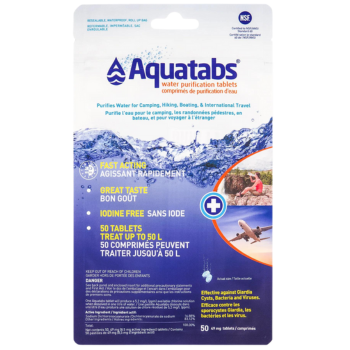
✅ Best overall
✅ Neutral taste
✅ Works fast
❌ No major cons
KEY SPECS
- Weight: 0.32 oz
- Wait Time: 30 minutes
- Protects from: Bacteria, Viruses, Giardia
- Shelf Life: 5 years
- Amount of Water Treated per Tablet: 2 L
- Ingredients: Sodium Dichloroisocyanurate
Trusted by Aid Agencies around the globe, a single Aquatab can treat up to two quarts of water if it’s relatively clean, 0.8 quarts if less so. We like that each tablet is individually packaged, making these easy to pack and keep dry. We like that they work in just 30 minutes, the fastest we tested. They protect against bacteria, viruses, and giardia but won’t kill cryptosporidium. Price-wise these are mid-range.
Our favorite thing about these tablets is what they don’t have - any chemical taste. Each pack has a shelf life of five years, and unlike other options, Aquatabs claims its pills are safe for long-term use. Aquatabs are our pick as the best overall water purification tablet.
Water purification tablets with the best protection
Potable Aqua Chlorine Dioxide Water Purification Tablets
Price: $12.99
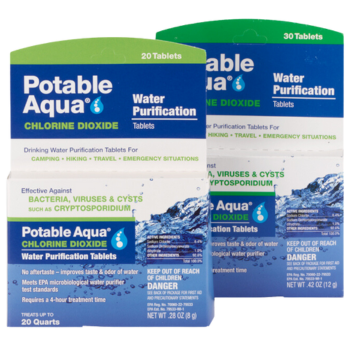
✅ Best protection against disease
✅ Taste not noticeable
✅ Affordable
❌ Long wait time
KEY SPECS
- Weight: 0.96 oz
- Wait Time: 4 Hours
- Protects from: Bacteria, Viruses, Giardia, Cyptosporidium
- Shelf Life: 4 years (opened), 1 year (unopened)
- Amount of Water Treated per Tablet: 1 L
- Ingredients: Sodium Chlorite, Sodium Dichloroisocyanurate Dihydrate
Potable is a trusted brand that’s used by the military and worldwide emergency organizations like the WHO (World Health Organization). And we found they provide some of the best protection against disease, including cryptosporidium. These chlorine dioxide tablets purify one liter of water per tablet. We like that they come in a foil pouch, making them easy to use without contaminating the whole batch.
The five-year shelf life is also one of the longest we tested, making this a great option for your emergency kit. We thought the taste was fairly neutral with a little aftertaste, a big for any water purification tablet. The biggest downside for us is the long wait time of 4 hours. But if you need the best protection out there, Potable Aqua Chlorine Dioxide tablets are our top choice.
Best budget water purification tablets
COGHLAN’S DRINKING WATER TABLETS
Price: $10.49
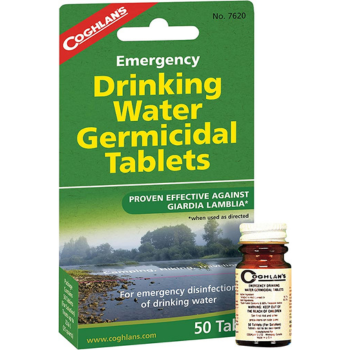
✅ Best budget buy
✅ Works fast
❌ Strong iodine taste
KEY SPECS
- Weight: 0.64 oz
- Wait Time: 30 minutes
- Protects from: Giardia
- Shelf Life: 4 years (opened), 1 year (unopened)
- Amount of Water Treated per Tablet: 0.5 L
- Ingredients: Tetraglycine Hydroperiodide, Titratable Iodine
Coghlan’s created this water purification tablet for emergency use. We like that it’s the cheapest option on our list and it works fast, in just 30 minutes. A great budget buy. This is tied to the quickest treatment time of all the water purification tablets we tested. These are iodine tablets for water, so while the taste was not as bad as we expected, it was still noticeable.
These tabs protect against bacteria, viruses, and giardia but not against cryptosporidium. The tablets have a four-year shelf life, but be sure to keep the glass bottle sealed when not in use, as exposure to moisture or humidity can alter the tablets’ effectiveness.
The Other Noteworthy Models
KATADYN MICROPUR MP1
Price: $15.95
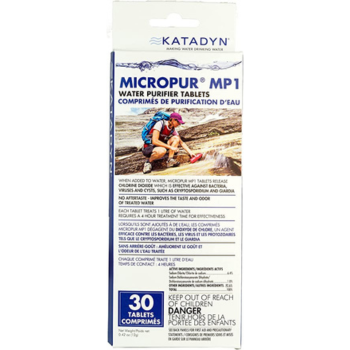
✅ Excellent protection
✅ Not much taste
❌ Long treatment time
❌ Expensive
KEY SPECS
- Weight: 0.9 oz
- Wait Time: 4 Hours
- Protects from: Bacteria, Viruses, Protozoa
- Shelf Life: 5 years
- Amount of Water Treated per Tablet: 1 L
- Ingredients: Chlorine Dioxide
Katadyn Micropur MP1 is a powerful tablet that is a proven reliable option for water treatment. We like that a single tablet will purify up to one liter of water, no matter the water’s condition. And it protects against cryptosporidium too. Compared to other options we found that there is less of a lingering aftertaste. The tablets are also EPA registered in meeting the standard of safe microbiological water purifiers. Each pill comes in individual foil packaging and has a 5-year shelf-life.
The downside for us is the long wait time of 4 hours to achieve complete treatment. These are also some of the most expensive water purification tablets we tested. But if you need a heavy-duty water treatment tab, the Katadyn Micropur MP1 is an excellent option.
Potable Aqua Water Purification Tablets
Price: $15.99
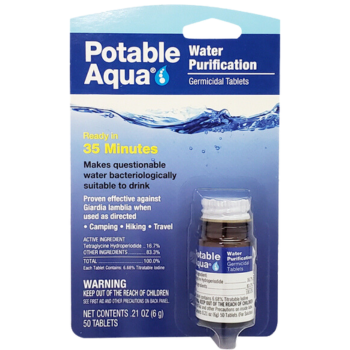
✅ Short wait time
❌ Expensive
KEY SPECS
- Weight: 2.24 oz
- Wait Time: 35 minutes
- Protects from: Bacteria, Giardia
- Shelf Life: 4 years (opened), 1 year (unopened)
- Amount of Water Treated per Tablet: 2 L
- Ingredients: Tetraglycine Hydroperiodide, Titratable Iodine, Diatomic Iodine, Hypoiodous Acid
Potable makes iodine tablets for water that work in just 35 minutes, one of the fastest we tested. They protect against bacteria, viruses, and giardia. They won’t protect against cryptosporidium though.
Iodine tablets for water are known for their strong taste. Potable counters this by providing a PA+Plus neutralizing tablet to improve the iodine’s taste and color that you can add after you treat the water with the iodine tablet. We found this does improve the taste but it still is noticeable. We don’t like that these come in glass bottles, which are less friendly to pack.
Key Factors To Consider When Choosing
Price
Water treatment tabs are an affordable backcountry item costing between $10-$15 for a pack. Look for how much water each tablet can when assessing what gives you the most bang for your buck.
Water purification tabs that provide the greatest value:
Affordable water purification tabs:
Premium water purification tabs (most expensive):
Wait Time
Water purification tablets require waiting for chemicals to treat the water. Water treatment tabs allow you to drink water faster, but don’t protect against diseases like cryptosporidium. Long wait times offer more protection but require planning ahead. This can be tricky, especially in hot environments.
The water purification tabs with the shortest wait time:
Protection
Unlike water filters, water purification tablets use a chemical treatment to kill the harmful bugs in your water. For most backcountry uses any water treatment tab will do. The water purification tabs with the most protection will protect against diseases like cryptosporidium. If you know you’ll be in an area with cryptosporidium make sure you get tablets that offer this protection.
The water purification tabs that offer the best protection:
Other Things to Consider
Taste
Not all water purification tablets taste the same. Some tablets can give off a strong chemical smell and flavor, especially the chlorine and iodine ones. This can lessen by letting the water “air out” during treatment or by using an iodine-neutralizing pill. If you're packing tablets for emergency use only taste is less important. If you plan on using them instead of a filter for a whole trip, we recommend you test them out before you buy a week's worth.
Amount of Water Treated per Tablet
Read the instructions carefully to know how much water will be treated per tablet. If you add too much water the tablet may be too diluted to work. If you add too little the chemical taste of your water could be too strong to drink. We recommend choosing a water purification tablet that can treat a similar amount of water as the size of your water bottle. That makes the math easy. Just pop in a tab and wait.
Shelf Life
A common strategy for water purification while backpacking is to use a water filter and pack purification tabs as a backup method. If you’re doing this, you’ll want a long shelf life since you hopefully will only use them occasionally. Most water purification tablets will last 4 to 5 years unopened and 1 year after opened. Look for individually wrapped tablets to give you the longest shelf life.

Potable Aqua Chlorine Dioxide Water Purification Tablets.
Active Ingredient
Ingredients-wise there are three main chemicals used to make tablets: iodine, chlorine, and chlorine dioxide. These chemicals are the most effective in killing off harmful pathogens while remaining safe for human consumption.
Below are a few notable details about the three common chemicals used in water treatment tabs:
IODINE:
- Fights bacteria, viruses, Giardia.
- Works best in warm water, as Iodine’s effectiveness slows down in cold water, and it’ll take longer to disinfect.
- The amount of Iodine needed to purify water changes depending on how contaminated or cloudy the water is.
- Iodine tablets for water leave a strong, rust-like aftertaste.
CHLORINE (BLEACH):
- Fights bacteria, viruses, Giardia.
- Works better in a pill than in liquid form because of the additional sodium-based ingredients.
- Will work in a large assortment of pH levels.
- Strong chemical smell and aftertaste
- Water treated with chlorine shouldn’t be left in storage or it can lead to recontamination.
CHLORINE DIOXIDE:
- Fights bacteria, viruses, parasites, Cryptosporidium, and Giardia.
- Requires a longer treatment time.
- Though slightly more expensive than the other two chemicals, chlorine dioxide tablets kill a greater range of microorganisms, making them the superior choice in water treatment options.
- Doesn’t leave much of an aftertaste.
Note: Since different water treatment tabs offer different levels of protection, you’ll want to read the fine print on the packaging and do some research into the area you’ll be traveling to get a better idea of its water contamination level. Knowing these facts ahead of time and even checking in with local rangers or other sources in the area, can help zero in on the best tablet for your trip.
Weight
Water purification tablets weigh almost nothing. The packaging will often weigh more than tablets. If you have tablets that come in a glass jar we recommend repackaging them for your trip to save weight. The least fussy are water purification tablets that come individually wrapped. They also will last longer and be more protected from getting wet.
Packaging
Water purification tablets come in two forms. Glass bottles and foil-sealed packages. Glass bottles often hold more tabs but are prone to breaking and getting contaminated. If moisture or humidity gets into the bottle it can lessen, or ruin, the effectiveness of the tablets. Foil packaging is our favorite because it is lightweight and keeps each water purification tablet sealed. We’ve even had them go through the wash and come out unscathed!

Water purification tablets by Coghlan's.
What Are Water Purification Tablets?
WHAT ARE THEY FOR?
There are many situations where water tablets can come in handy, and they can be used on all kinds of biologically contaminated water whether it’s collected from swamps, rivers, lakes, etc. Depending on the water’s turbidity, it may require a larger chemical dose. Tablets do not, however, treat “toxic water” that’s been altered by pesticides, mines, or any sort of chemical contamination.
For most casual hiking or backpacking trips though, the majority of tablets should work just fine. Water treatment pills are good for camping, as a backup plan on long treks into remote locations, or for use to purify water sources following a natural disaster. They’re also not a bad thing just to have on hand for emergencies.
HOW DID THEY COME ABOUT?
Growing concerns about water safety came into play in the 1800s during a major cholera outbreak in London. Years later, a British scientist named John Snow linked the disease spread to polluted drinking water. From there, he went on to figure out that chlorine could be safely added to water systems to act as a bacterial disinfectant.
Snow’s theory spread worldwide in the early 1900s and chlorine began being used as a water sterilization method throughout major cities. Then, in the 1940s Harvard University developed the first portable water treatment tablets. They were originally created for use by the U.S. Army and given to soldiers to carry in their packs for sterilizing water during emergencies. Since then, water purifying tablets have been tweaked and refined, bringing us the large variety we currently have today.
HOW DO THEY WORK?
Even when a stream, river, or lake appears crystal-clear, it can still contain heaps of dangerous microorganisms that when ingested bring on a slew of gastro issues like diarrhea, vomiting, or in more serious cases, illnesses that can even lead to death. This is why it’s important that any water collected from an untreated source first be sterilized before drinking it.
Although it may sound odd to hear the words “chemicals” and “drinking water” paired together in a positive light, tablets contain a safe amount of chemicals that when dropped in water dissolve and go to work on “killing off” dangerous microorganisms like bacteria and viruses, making the water safe for human consumption.
ARE THEY EFFECTIVE?
Water purification pills can eliminate harmful water threats like viruses and bacteria, including common gut destroyers like E. coli, Salmonella, and Cholera. However, it’s important to note that tablets DON’T eliminate chemical pollutants, sediment, or certain protozoans.
How strong a tablet is and what it protects against will depend on its chemical makeup. For example, chlorine dioxide tablets are effective against Cryptosporidium, but a scientific study performed by the Department of Soil, Water, and Environmental Science at the University of Arizona in Tucson proved that iodine tablets are ineffective in safely deactivating Cryptosporidium.
The water’s temperature along with its pH level is another consideration, as these factors can alter the effectiveness of a tablet.

Water purification tablets side by side.
Water Purification Tablets vs. Other Purification Methods
Bottom line: should you use water purification tablets for your water purification needs?
✅ WEIGHT: ULTRALIGHT
Tablets take minimal space in your pack and weigh as little as a fifth of an ounce. To put that in perspective, a Sawyer filter and a Steripen weigh 2 and 5 ounces, respectively.
✅ SHELF-LIFE: LONG
Unopened, purification tablets have a shelf-life of approximately 5 years.
✅ COST: CHEAPER UP-FRONT
When compared to filters, water purification tablets are a cheaper up-front option. Why up-front? Tablets are single-use while other purification methods will filter hundreds of gallons of water before needing to be replaced.
✅ EASE OF USE: SIMPLE AS 1-2-3
Besides a container to hold the water in, they don’t require any special equipment, additional fuel for heating, or electricity. Drop 'em in and wait.
❌ LONG-TERM USE: NOT DESIGNED FOR CONTINUOUS USAGE
Tablets shouldn’t be a long-term solution to treating water, as their chemical make-up is safe in small quantities, but isn’t intended for extended use (like over six months).
❌ TASTE: OFTEN GIVES OFF A CHEMICAL TASTE
Another downfall to tablets is how they give off a strong chemical smell and flavor, especially the chlorine and iodine ones. Note this can lessen by letting the water “air out” during treatment or by using an iodine-neutralizing pill.
❌ PREP TIME: ABOUT 30 MIN. OF WAITING TIME
Compared to filters, tablets don’t offer immediate clean water like a filter can, since adequate time is needed for them to do their work. Just know that they don’t provide immediate results, and you’ll have to wait anywhere from 30 minutes-4 hours when using them for water to become safely drinkable.
❌ EFFECTIVENESS: NOT AS PURE AS OTHER METHODS
Another consideration is that according to the CDC, out of the various ways of sterilizing water, boiling remains the most effective in removing harmful pathogens. Filters are also known to provide the “cleanest” tasting water, and they block dirt and debris without having to pre-filter the water, which is a necessity with tablets.
 Taste neutralizing tablets take about 3 minutes to take effect.
Taste neutralizing tablets take about 3 minutes to take effect.
How to Use Water Purification Tablets
STEP-BY-STEP:
- First, make sure you have a clean container to store your water in.
- After you’ve gathered the water, do your best to strain it before adding the tablets as this will get out the excess dirt and debris. Either running it through a clean cloth, coffee filter, paper towel, or bandana will work.
- Read through the instructions on the packaging, and measure out the amount of water that can be sanitized per tablet (or tablets.)
- Drop in the recommended number of tablets.
- Place the cap loosely on your water container, and swoosh the water around so it reaches every area, including the lid.
- Wait around five minutes or so.
- Then (with the cap on, but still a little loose), give the container a good shake to again cleanse the entire inside of the bottle, including the screw threads near the cap!
- Set the bottle down and wait for the recommended time. This can range between 30 mins-4 hours, depending on the tablet and your circumstances.
- You can wait with the bottle cap on or off. If using a chlorine-based tablet, having the cap off can help to “air out” the chemical taste and smell.
- After the time’s up, you’re good to go! Drink up!
 Fizzing vs dissolving water purification tablets (Left: Potable | Right: Coghlan's).
Fizzing vs dissolving water purification tablets (Left: Potable | Right: Coghlan's).
FAQs
ARE WATER PURIFICATION TABLETS SAFE?
Yes, water purification tablets are generally safe when used properly. They should be used sparingly, however, and not as the main source of acquiring clean water for months on end. Iodine pills can be especially dangerous when used for long periods, and they shouldn’t be taken by women who are pregnant or anyone with iodine sensitivities or thyroid issues.
WHAT ARE THE RISKS OF WATER PURIFICATION TABLETS?
As long as you’re buying from a reputable company and the pills are taken properly and in small amounts, you’ll be good. The pills should never be swallowed whole, and they should be handled with care when being used, as the chemical residue left on hands can irritate eyes and skin causing a burning or itching sensation.
Lastly, if you’ve never used tablets before, the chemicals in them may cause mild stomach, mouth, and throat irritation upon the first few uses, although, this doesn’t happen for everyone.
WHAT DO WATER PURIFICATION TABLETS TASTE LIKE?
Water purification tablets' taste varies depending on the type of chemical used. Iodine, for example, gives off a more metallic flavor, and it can even turn your water (and your water bottle) a rusty hue. Chlorine can have a strong chemical flavor and give off an unpleasant bleach smell. This can be reduced by letting the water ventilate for a while. Chlorine Dioxide is a chemical that remains rather flavorless. Some users even say they think it improves the taste of water.
DO WATER PURIFICATION TABLETS EXPIRE?
Yes, they do BUT most tablets have a long shelf life, lasting months or even years depending on the brand and packaging. To ensure this long shelf, it’s best to store them in a safe, dry place when not in use, and when using a bottle be sure to recap the bottle tightly. Naturally, individually wrapped tablets will have a longer expiration date compared to a bottle once it’s been opened. Once a bottle has been opened it’s recommended the pills be used within three months.






 650-Calorie Fuel
650-Calorie Fuel



